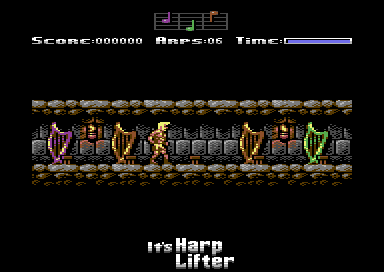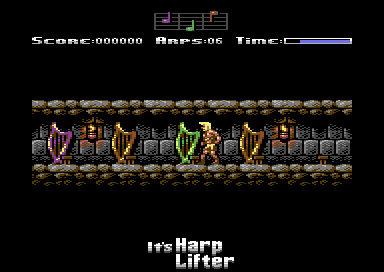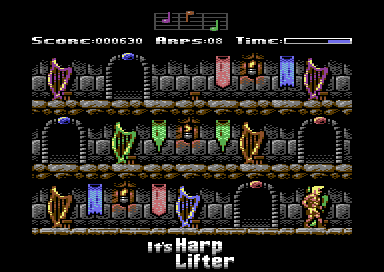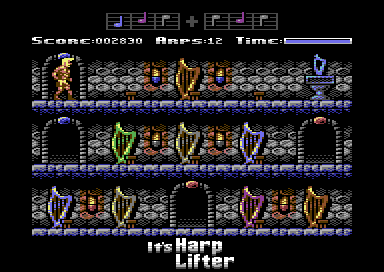Today's title is a single-screen action/puzzle game with a theme that is plenty puzzling all by itself. It's Harp Lifter!
Wait, actually, it's It's Harp Lifter. I mean, It's is part of its name. It starts with It's.
Let's just move on, shall we?
The somewhat baffling loading screen certainly makes it clear that the game's name is to be taken literally. That is indeed a harp, and there is some heavy lifting going on. To what purpose remains shrouded in mystery, at least for now. I'm not sure if the bearded guy's facial expression is supposed to suggest enjoyment or strain. It could be both, for all I know. Printed on a street poster, this picture could probably masquerade as an advertisement for a gym whose training equipment is weirdly music-themed.
Hopefully, the game can shed some light on what is happening here...
The intro sequence reveals that the ghost of a certain Lady Helena is haunting Verismo Keep, and she has brought her league of metaphysical harpists with her. At first, her presence was considered a charming addition to the keep, but she soon became increasingly aggravated by the lack of music within the stronghold's walls. Now that she has started throwing objects at the living inhabitants, the situation has become unbearable. The only way to appease (and ultimately get rid of) Lady Helena is to place harps in the keep's halls in specific patterns which should compel her spooky harpists to play ghost-soothing arpeggios.
Cedric Hahn is a diligent carpenter, earning his living by providing the populace with sturdy furniture. However, in times of great need, he puts away his woodworking tools, takes off his shirt and becomes...
... HARP LIFTER, the legendary lifter of harps! Look at him, lifting that harp! He has just heard of Verismo Keep's severe ghost problem and immediately heads there to provide his special power of lugging heavy string instruments around.
So much for the backstory. I might need some plot clarifications later on, but it's probably best if I just start the game.
This Get Ready screen makes it sound like I'm going to employ the harps as guns. I can't imagine that this is going to be a shooting gallery...
... even though the game's first level very much looks like an amusement park attraction.
Cedric's epic quest for harp shuffling starts in this single corridor. There are four harps plus one lonely stool. The stools denote spots where harps can be placed. The ghost harpists may be intangible, but they still require something to sit on when they play.
Apparently, Cedric's transformation to Harp Lifter caused his work pants to vanish as well, so now he's running around in nothing but his shorts and boots. I guess it's only fair that, for once, it's a guy wearing a skimpy outfit which is completely impractical for the job. With the blond facial hair and the shorts, Cedric's sprite looks suspiciously like an off-brand professional wrestler. Come to think of it, Harp Lifter might just as well be an actual wrestler's stage name.
I wasn't sure about this whole hero-business, so I tried to leave the level. However, the keep's corridors follow the Pac-Man school of geometry and conveniently wrap around. Seems like there is no way out but to do as I am told.
Specifically, I am instructed to create a straight line of three harps in the color order indicated by the notes at the top. The direction does not matter, so I can set up the sequence from left to right or from right to left.
Cedric doesn't have superhuman strength, despite his muscular frame, thus he can only carry one harp at a time. Pressing fire prompts him to pick up a harp if he is standing in front of one. While he is encumbered, Cedric moves at a slower pace. If I direct him to an empty stool and press fire again, Cedric deposits the harp there.
I have to say, Cedric's superpower is a bit underwhelming compared to how much it was played up in the intro sequence.
Pressing fire in front of a harp when Cedric is already carrying one causes him to quickly swap both instruments. I have to give him this one, at least: Juggling two harps as quickly as that isn't something a normal person could pull off. Cedric can even do this while walking, which saves quite some time.
Speaking of which, time is in limited supply, indicated by the dwindling blue bar in the top right. If it runs out, Lady Helena will lose her patience and start an ectoplasmic attack on our hero.
Once three harps are in the right color order, three spectral harpists materialize and play the arpeggio, one note per harp. I feel there are more efficient ways to make music, but I'm admittedly no expert in the appeasement of angry audiophile ghosts.
Arpeggios & SID Music An arpeggio is a chord whose notes are played rapidly one after another (instead of at the same time) in a rising or descending order. It's Harp Lifter sometimes stretches this definition a bit by featuring sequences that zig-zag wildly across the scale. The word comes from the Italian "arpeggiare" which means "to play on a harp". Maybe this explains the game's apparent obsession with the string instrument. Arpeggios feature prominently in a lot of tunes composed for the C64's SID chip. Here's an example from Puzzle Shuffle which, right at the start, features two channels that use arps at different speeds: The SID chip only supports three voices which means that playing a three-note chord would use all of them. A lot of C64 musicians deal with this issue by having one channel play the chord as a rapidly looping arpeggio. The faster the broken chord is played, the less distinct the individual notes become, and the more it appears like a proper chord. The result is that characteristic warbling sound many SID tunes are known for. |
Each time an arpeggio is completed, some bonus time is added and the "Arps" counter goes down by one. This number indicates how many arpeggios still need to be played. When it reaches zero, Lady Helena has heard enough plinky plonk in this corridor, and Cedric can move on to the next level.
The first level is a simple affair that introduces Cedric's basic moveset. Since all harps are in close vicinity, there is more than enough time to fulfill the demanded arp quota.
LEVEL 2
The second level steps things up by adding a second level. The two corridors are connected by stairs that are accessible through the stone arches. Luckily, the stairways are spacious enough that Cedric can carry a harp with him when going up or down, and there is virtually no delay when traveling between floors.
Moving between floors is very much required. The first arpeggio I have to create in this level calls for harps from both corridors. There aren't enough stools to move all harps to one floor, thus some vertical movement is necessary.
LEVEL 3
Level 3 adds yet another hallway and restricts the harp locations to two vertical lines. This is the game telling the player that harps can be lined up vertically as well. There are two pairs of stone arches now, and they are conveniently color-coded to indicate which ones are connected.
While the time limit is still generous, the harp hauling gets a bit more frantic here, as Cedric has to move between floors quite frequently.
LEVEL 4
All the harps are located in diagonal patterns here. Maybe ghost summoning requires harp constellations like these. Or maybe, just maybe, the level's purpose is to show the player that diagonal matches work as well.
At first, I thought the placement of the colored banners had some significance here, but that does not seem to be the case. They're just there for decoration and, most likely, to confuse the player.
This level also represents the first opportunity to create several matches at once which earns additional points and, more importantly, doubles the time bonus. Unfortunately, it usually takes me so much longer to spot and execute these double matches that I end up losing time.
The game becomes noticeably harder here, at least that's how it feels to me. I find myself panicking a bit whenever a new arp appears, especially if the timer is running low. Instead of running around, I should take a moment to calmly look at the screen and try to identify any lines that almost match. The game has to bring up harp combinations that aren't already present, or they'd trigger immediately. Thus, the more harps a level has, the bigger the chance that two harps are already in the correct position or just need to be swapped to get the right sequence.
LEVEL 5
The square grid of nine harps opens the opportunity to create lines in all eight directions. If you look at the top of the screen, you can see that this level provides two arps simultaneously. If one of them matches, it gets replaced with a new sequence. It's also possible to create matches for both arps at the same time, but that requires proper planning ahead (i.e. the opposite of what I'm doing).
The dense cluster of harps in combination with the two available arp sequences makes this level feel very fast-paced. It can even happen that I trigger an arpeggio by accident, simply because there are so many lines on the screen simultaneously.
The next few levels don't offer anything particularly new, so let's skip ahead a bit...
LEVEL 8
Although this layout looks very similar to the one from level 5, it plays quite differently because the middle floor cannot be accessed. This forces the player to arrange the harps with a fixed middle section or to use horizontal lines only (which require lots of vertical movement and take longer to build).
LEVEL 10
Overwhelmed by the sheer number of harps, I started making several mistakes in a row here and took too long to complete all arps.
Once the time limit runs out, the game does not end immediately. However, Lady Helena gets angry and starts roaming the hallways to catch Cedric. She always appears at the far end of the floor where Cedric is currently located and rapidly flies through the corridor. It is possible to evade her by either taking the stairs to another floor or by leaving the hallway on one side and entering from the other. If she misses Cedric, she reappears after a short interval and tries again. This keeps on going until she either touches Cedric or he manages to complete the remaining arps.
As you can see in the above animation, I managed to avoid her for a brief (and very tense) time, but Cedric got slimed eventually. If I get caught by Lady Helena, I have to restart the level and the number of required arpeggios gets reset. If Cedric gets slimed for the third time, his body has become too slippery to lift any harps, and the game is considered to be over.
Having finished the first ten levels, I get handed a password in the manliest way possible...
 |
| I could've guessed that one! |
... by having sprite letters appear on Harp Lifter's forearm. I hope these password tattoos are not permanent, or Cedric will end up with more writing on his body than Leonard from Memento.
LEVEL 11
Cedric has entered a new part of the keep where the walls look slightly more upper-class. Lady Helena's music taste also has become more finicky, as she now demands that two arpeggios are set up simultaneously (hence the plus sign between the arps at the top). This means that the harpists will only appear once both sequences have been created, like this:
Positioning all the harps correctly obviously takes longer, but resolving two arps at once also gives back more time. I'm not very good at spotting combinations, so I wasted precious seconds running around like a headless chicken before I got my bearings.
This level introduces an altar with a miniature harp on it. If I press fire while standing in front of it, the currently required arps are replaced with new ones, at the cost of a bit of time:
I can activate the altar if I feel like it'd take me too long to position the harps, or if I encounter a situation like this:
These two arpeggios are impossible to set up concurrently, as I'd either need two violet harps or three gray harps. Lady Helena is apparently mean enough to impose these unsolvable problems on Cedric in the hopes that he wastes time trying to work them out. Luckily, this doesn't happen very often, but if you're unsure whether a combination can be done or not, don't hesitate to use the altar.
LEVEL 16
Level 16 is all harps, all the time! The entire screen is filled with them, leaving no space for any doorways. For that reason, Cedric's movement is limited to the middle corridor. This constraint makes completing arps quite a bit faster, but the game nefariously compensates for that by having the timer go down noticeably quicker as well. It's quite stressful, as I don't want Lady Helena to appear where there is no way to get to another floor.
From here on out, the levels get harder, mostly thanks to a stricter time limit. I soon found myself having to deal with Lady Helena's presence more often. While it's cool that running out of time doesn't automatically end the game, the pace at which the enraged ghost speeds through the fortress is hard to keep up with for long.
Unless you are a natural pro at shifting harps, you'll eventually get to see this sad picture of a broken harp. I halfway expected a depiction of Cedric in a defeated (and slimed) pose here, but I guess he already went home to take a shower. There are no continues, but at least there is a password system.
I won't go through the rest of the levels because I'm sure you've witnessed more harps by now than you ever expected to see in a single C64 game. Let me just say that in the later stages things get a bit... weird:
I finished the game, but I won't show its ending sequence here. I found the conclusion to be pretty surprising, and it left me scratching my head (in sort of a good way). If you want to find out what happens, I suggest you play It's Harp Lifter for yourself.
CONCLUSION
To be honest, this is a weird game for me to judge for multiple reasons. I can't shake the feeling that the maker(s) of It's Harp Lifter started with nothing but the name, and all that followed was an elaborate attempt to make sense of the odd title. I tried to find some information about Reanth Soft, but a search came up with nothing. If anybody has some knowledge about them, please let me know.
Even though every level's harps always start in the same positions, the randomly appearing arps can change the flow of the game quite a bit. Sometimes it's easy to create several arps in a row just by moving one harp, and sometimes the required harps are on opposite sides of the screen. In that regard, the difficulty can fluctuate a bit from level to level, depending on what combinations you get. While it's tempting to create two matches at once to get an additional time bonus, it's all too easy to shuffle the wrong harps around and lose more time in the process.
It's Harp Lifter is probably not a game for people with color vision deficiencies. I know I'd have had a hard time telling some of the harps apart on my old monochrome monitor which displayed everything in shades of green.
On the music side, a pleasant two-channel tune is playing during the game while the third channel is reserved for sound effects, like the harps getting plucked in sometimes hilariously dissonant ways.
While I don't think that the concept is versatile enough to provide massive long-term motivation, I find it suitably entertaining for a quick round, at least until I've reached the next password. I recommend giving it a try, especially if you want to see the ending.
| ONE MORE THING... As you might have guessed by the release date of this blog post, It's Harp Lifter is not a real C64 game. It is an April Fools' joke that got a bit more elaborate than I had initially intended. My plan was to make up a fictional game based on an anagram of April the First and use it as an exercise to do more C64-related pixel art. However, in order to capture the animations, I "accidentally" created a fully playable prototype. I developed it on a PC, but I tried to adhere to the C64's restrictions when creating the graphics and gameplay elements, so it would look as legitimate as I could make it. The game still needs quite a bit of work, but I intend to eventually release it for free. |





























Amazing effort, how much time have you spent on it?
ReplyDeleteThank you! I started creating the prototype at the beginning of March, but by then I had already made a lot of the background graphics and sprite animations. The first image I created (a harp) dates back to August of last year. It turned out to be a fun project to leisurely work on during the weekends, so I didn't mind spending more time on it.
DeleteThis is pretty incredible. Lol!
ReplyDeleteThanks! :)
DeleteReally enjoying your blog! Thanks for doing your thing.
DeleteAnd thank you for reading it. I've been busy with other stuff lately, but eventually I'll continue writing blog posts.
Delete